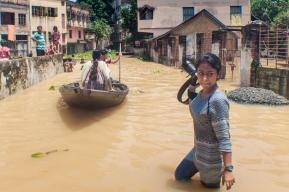观点
斯科特·库尔普:“海平面上升的危险已近在眼前”

“气候中心”(一独立的气候科学与新闻组织,总部位于新泽西州普林斯顿)研究发现,海平面上升危及的人数可能是此前预估的三倍。数百万人可能在2050年就因此被迫踏上流亡之路。针对这一情况,气候中心“海平面上升项目”高级计算机科学家和高级开发人员、2019年研究报告的主要作者斯科特·库尔普(Scott Kulp)利用人工智能进行了分析。
斯拉兹·西得瓦(Shiraz Sidhva) 担任采访
联合国教科文组织《信使》
你们的研究报告《被淹没的未来:海平面上升来势汹汹,全球脆弱性超出预想》指出,世界各地海岸线面临的风险超出预想。您对这个研究结果意外吗?
我们预想到自己的研究会揭露更多的全球风险,但达到这个程度却是始料未及的。我们的研究结果表明,预计在30年内,目前居住着3亿人的沿海地区每年至少会发生一次洪水。预计到2050年,1.5亿人的居住地将沉没到高潮线之下。也就是说,假如不在沿海地区采取防范措施,这些地方实际上将无法居住。
本研究采用的模型表明,在排放量较高、海平面上升对全球变暖极端敏感的情况下,到本世纪末,目前拥有约10%全球人口的地区会面临威胁——要么洪水频发,要么被永久淹没。
预计全球海平面在21世纪将上升多少?
大多数预测显示,到本世纪末海平面将上升半米至一米,而且上升速度会越来越快,更频繁、更严重的沿海洪水也将随之而来。
我们的研究发现,大致按照《巴黎协定》的建议削减全球碳排放量,到本世纪末就可以挽救现有3000万人居住的土地,使其免于遭受每年的沿海洪水肆虐或是被永久淹没。除此之外,这还将减轻气候变化带来的诸多其他风险。
哪些地区受影响最大?
海平面上升是一个全球性问题,每个沿海国家都无法幸免于难。但在今后几十年里,受影响最大的将是亚洲,这是由于亚洲沿海地区聚居着大量人口。预计到2050年,在低于沿海洪水年均水位的地区居住的人口将大多来自孟加拉国、中国、印度、印度尼西亚、泰国和越南。
到本世纪中叶,将有三亿人口居住的地区面临同样的风险,这部分人口中约有75%生活在这六个国家。
面对海平面上升、沿海洪水风险日益加剧的局面,一些国家已经大刀阔斧地采取了措施。例如,印度尼西亚已决定将本国首都从雅加达迁往加里曼丹岛上地势较高的地区。随着海平面不断上升,此类大规模举措将愈发普遍。
海平面上升是一个全球性问题,每个沿海国家都无法幸免于难
面对不可避免的海平面上升情况,受影响最大的沿海城市该如何作好准备?
根据CoastalDEM项目的评估,许多亚洲城市都有海拔低于当地高潮线的地区,这些城市分布在孟加拉国、中国、印度、印度尼西亚和越南。这或许表明,人们今天可以生活在这些地区,全仰仗海堤、堤坝和防洪堤等天然或人工的防御设施。
你可以在上海、荷兰和新奥尔良看到这方面的实例,占地广阔的沿海防洪工程守护着这些大城市。但随着海平面不断上升,维护和改善防御设施的成本将与日俱增,失败的代价也会愈发沉重。
还有一些天然的防护屏障,例如沙丘、湿地、与海岸之间的距离,都可以减轻沿海洪水对于脆弱土地的影响。但拜海平面上升所赐,这些屏障的保护作用将不可避免地大打折扣。
风险不仅限于亚洲。在法国、德国、英国、埃及、伊拉克、尼日利亚、巴西和美国等地,地势低洼地区都是大型社区所在地,由于沿海洪灾日趋严重,这些社区可能需要得到更多保护。
小岛屿发展中国家(SIDS)的现状如何?
从我们的研究中可以明显看出,小岛屿发展中国家面临着海平面上升的严峻风险,而其中许多国家没有足够的能力投资开展应对措施。
到2100年,预计马尔代夫近半数人口生活的地区将位于潮汐线以下,马绍尔群岛的这一比例约为80%。随着海平面上升,这些地区的沿海洪水将更加频繁,也更加严重,可能导致在本世纪结束之前这些地区实际上就已经无法居住。
威胁日益严峻,富裕国家的碳排放是罪魁祸首。假如得不到富国支持,小岛屿发展中国家的政府可能没有资源来帮助居民适应不断上升的海平面。
到2100年,预计马尔代夫近半数人口生活的地区将位于潮汐线以下
你们的CoastalDEM项目使用人工智能替代了美国航天局模型先前采用的卫星数据。这种新技术有哪些好处?
要了解未来海平面上升带来的真正威胁,就必须更好地测量我们脚下的土地。这就是CoastalDEM项目的宗旨所在。
我们利用机器学习开发出了新的数据集,其在精确度上远远高于美国航天局的航天飞机雷达地形测绘任务(SRTM),特别是在人口稠密地区——也就是多数居民和建筑物都遭遇海平面上升影响的地区。
我们的工作尚有完善的空间,而且也应该有所改进。但对于许多沿海国家的规划者来说,要评估海平面上升风险,这个项目就是最准确的资料来源。
应鼓励政府采取哪些最关键的措施来缓解这场危机?
要保护受海平面上升威胁的民众和土地,政府所能采取的第一个、也最为关键的步骤,是运用现有的最佳资源来评估风险。但是,国际社会作出努力,减少碳排放量并遏制全球变暖, 对于应对这一风险同样至关重要。这些努力可以减缓海平面上升的速度,让弱势社区有更多时间进行规划和应对这场危机。
假如政府希望减轻沿海洪水在今后造成的影响,可以避免在高风险的洪泛区启动新的建筑工程项目,同时保护或迁移现有的基础设施和居民区。
海平面上升的危险已近在眼前,今天的社区不仅要为子孙后代作出选择,更要为自己作出选择。
拓展阅读:
使用气候中心互动式沿海风险筛查工具,预测全球海平面上升和沿海洪水威胁。
《未来的难民将是气候难民》,联合国教科文组织《信使》,2009年第10期。
《国际团结与气候变化》,联合国教科文组织《信使》,2019年7-9月。
订阅联合国教科文组织《信使》,阅读发人深省的时事文章,数字版免费。
在社交网络上关注联合国教科文组织《信使》:微博、微信公众号“联合国教科文信使”、Twitter、Facebook、Instagram。
Interview by Shiraz Sidhva
The UNESCO Courier
According to your study, Flooded Future: Global Vulnerability to Sea Level Rise Worse Than Previously Understood, coastlines across the world are more exposed than was previously thought. Were you surprised by the results?
We expected our study to reveal more risk worldwide, but not to the extent we saw. Our findings show that within thirty years, coastal flooding can be expected at least annually on land that is currently home to 300 million people. And 150 million people live on land expected to fall below the high tide line by 2050, meaning that without coastal defences, those places could be practically uninhabitable.
Under a higher-emissions scenario, and near the tail-end of sea-level rise sensitivity to warming for the model used in this study, land that is home to about ten per cent of the world’s population could be threatened by the end of the century, either by chronic flooding or permanent inundation.
By how much are global sea levels expected to rise in the twenty-first century?
By the end of this century, most projections show sea levels increasing by half-a-metre to one metre, with an accelerating rate of rise, and that would accompany more frequent and more severe coastal floods.
Our study found that cutting global carbon emissions roughly as proposed in the Paris Agreement could, by the end of this century, prevent the risk of annual coastal floods and permanent inundation from expanding to land now home to thirty million people. But beyond that, this would reduce the danger of many other risks of climate change.
Which regions will be most affected?
Sea level rise is a global story, and it affects every coastal nation. But in the coming decades, the greatest effects will be felt in Asia, because of the number of people living in the continent’s coastal areas. Bangladesh, China, India, Indonesia, Thailand and Viet Nam are home to the most people on land projected to be below average annual coastal flood levels by 2050.
Together, those six nations account for roughly seventy-five per cent of the 300 million people living on land facing the same vulnerability at mid-century.
Some countries have already taken drastic measures to respond to mounting coastal flood risk at least partly driven by sea level rise. Indonesia, for example, has taken the decision to move its capital from Jakarta to higher ground on the island of Borneo. As oceans continue to rise, large-scale initiatives like this will become more and more common.
Sea level rise is a global story, and it affects every coastal nation
How can the most affected coastal cities prepare themselves for the inevitability of rising seas?
A number of cities throughout Asia – in Bangladesh, China, India, Indonesia, Viet Nam – include land whose elevation was determined by CoastalDEM to be lower than the local high tide line. That’s probably an indication that natural or man-made defences like sea-walls, dykes and levees are allowing people to live there today.
You can see examples of these in Shanghai, as well as in the Netherlands and New Orleans, where extensive coastal flood control projects protect large cities. But as sea levels continue to rise, so will the cost to maintain and improve those defenses, and so will the cost of failure.
There are also examples of natural defences, like dunes and wetlands and distance from the coast. All of these are likely to be limiting the impact of coastal floods across vulnerable land today, but rising seas will inevitably reduce the protection they offer.
The risk is not limited to Asia. In France, Germany, and the United Kingdom; in Egypt, Iraq, and Nigeria; in Brazil and in the United States, low-lying land is home to large communities that will likely need more protection as the severity of coastal flooding increases.
What is the current situation of the Small Island Developing States (SIDS)?
Our research highlights the severity of the sea level rise risk faced by SIDS, many of which are under-equipped to invest in responses.
In the Maldives, roughly half of the population lives on land projected to fall below the tideline by 2100. In the Marshall Islands, that figure is roughly eighty per cent. As seas rise, coastal flooding in those areas will be more frequent and more severe, which could make them practically uninhabitable well before the end of this century.
These mounting threats are largely the result of wealthier nations’ carbon emissions, and without those nations’ support, SIDS’ governments may not have the resources to help their residents adapt to rising seas.
In the Maldives, roughly half of the population lives on land projected to fall below the tideline by 2100
Your project, CoastalDEM, uses artificial intelligence (AI) instead of the satellite data used by previous NASA models. What does this new technology have to offer?
Understanding the real threat posed by future sea level rise requires a better measure of the ground beneath our feet. That is the purpose of CoastalDEM.
Developed using machine learning, the new dataset is substantially more accurate than NASA’s Shuttle Radar Topography Mission (SRTM), particularly in densely populated areas – precisely those places where the most people and structures are threatened by rising seas.
Our work can and should be improved upon, but for planners in many coastal nations, it represents the most accurate source available to assess the risks posed by rising seas.
What are the most crucial steps that governments are being encouraged to take to mitigate the crisis?
Assessing risk using the best resources available is the first, and most crucial step that governments can take to protect the people and places threatened by rising seas. But international efforts to reduce carbon emissions and global warming are essential to managing this risk because they can slow the pace of sea level rise and give vulnerable communities more time to plan and respond to this crisis.
If governments seek to limit future impacts from ocean flooding, they could also avoid new construction in areas at high risk of inundation, while protecting or relocating existing infrastructure and settlements.
Sea level rise is a near-term danger: today’s communities must make choices not just on the behalf of future generations, but also for themselves.







